
New in RewardsWP: Points, Redesigned Rewards Widget & More
RewardsWP now includes Points, a redesigned Rewards Widget, and new tools to launch, run, and measure loyalty and referrals in one place.
Continue Reading →
RewardsWP now includes Points, a redesigned Rewards Widget, and new tools to launch, run, and measure loyalty and referrals in one place.
Continue Reading →
Want to set up affiliate terms and conditions for your WordPress affiliate program?
We’re going to show you the quickest way to draft and publish an affiliate partnership agreement that protects your business.
Here’s what we’re going to discuss:
Read on to find the best way to set up your affiliate terms and conditions.
Every transaction, whether buying groceries at the store or paying a plumber to fix the sink, is governed by a contract.
The basic premise of that contract is that you pay an agreed-upon amount in return for a certain service, but it goes much deeper than this.
Affiliate marketing is transactional: you’re paying a commission for a referral, and so it, too, needs to be covered by a contract.
Again, the basic premise is that your affiliates receive a certain reward for a specific action, but the relationship details are much more intricate than that.
Your affiliate terms and conditions govern your affiliate relationships and the transactions you have with your program members.
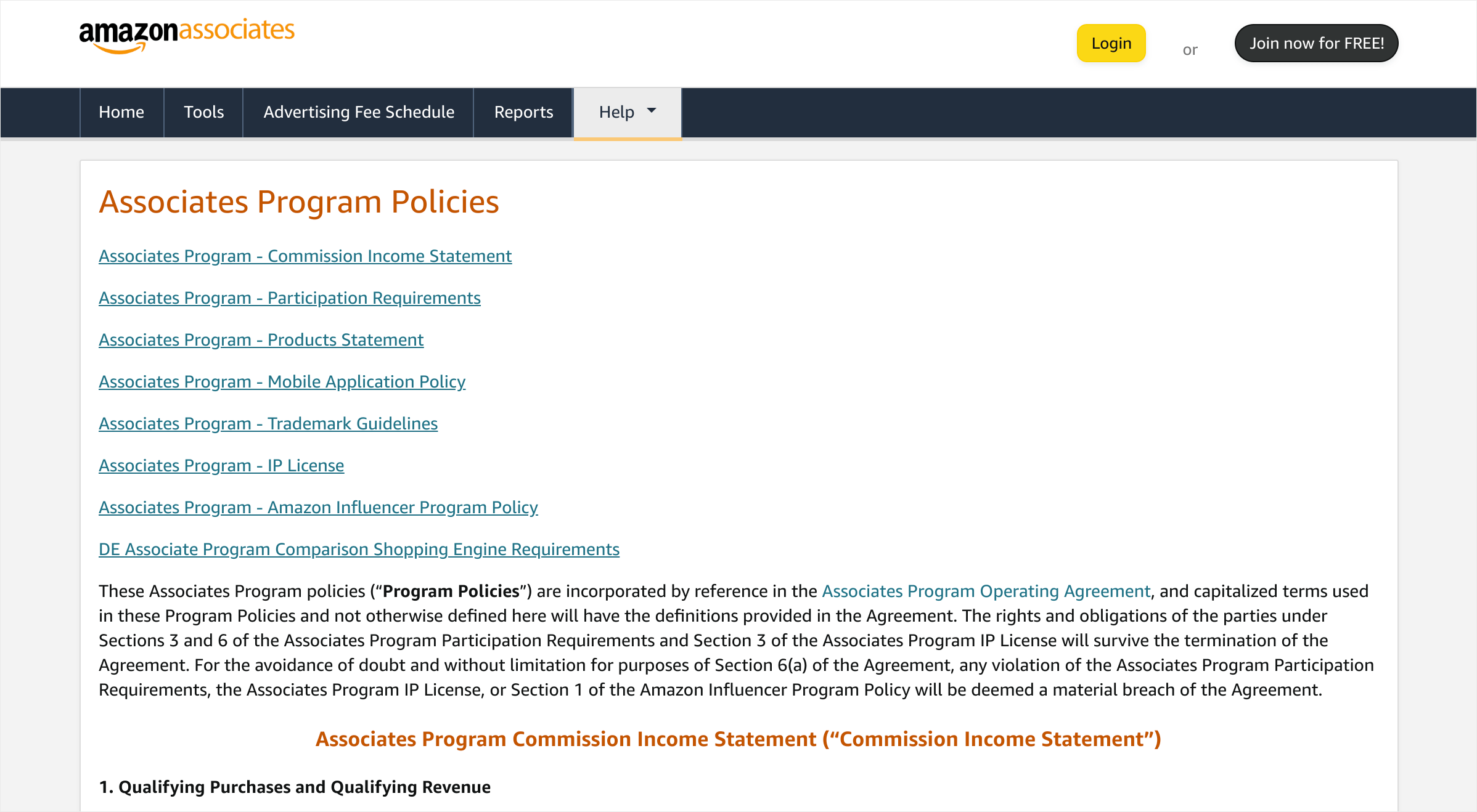
Without clear guidelines, building trust and ensuring an affiliate program that’s fair to both parties is impossible.
This means your affiliate terms and conditions should be one of your priorities when you start your affiliate marketing program.
Setting up your affiliate terms and conditions in WordPress couldn’t be easier.
Just follow these four simple steps.
If you’re looking to start a new affiliate program, you can jump straight in with these steps.
However, if you’ve already got an affiliate plugin on your site, it’s not too late to migrate over to AffiliateWP.
We’ll make the transition simple, and as you’ll see, we also make it incredibly easy to get an affiliate program set up (complete with robust affiliate terms and conditions).

AffiliateWP is the best affiliate management plugin for WordPress, and it’s got all the tools you need to draft a comprehensive affiliate terms and conditions page.
Head to the pricing page and select the plan that best fits your needs, and you’re ready to get started.
Follow this easy guide to download and install the plugin, and then open the setup wizard in your AffiliateWP settings to integrate your products in just a few clicks.
Once everything is synced, you’re ready to create your affiliate terms and conditions (affiliate partnership agreement) page.
This easest way to create your terms and conditions page is with AffiliateWP’s free Terms of Use Generator.
Just click Tools underneath AffiliateWP in your WordPress dashboard and then choose the Terms of Use Generator tab at the top of the screen.
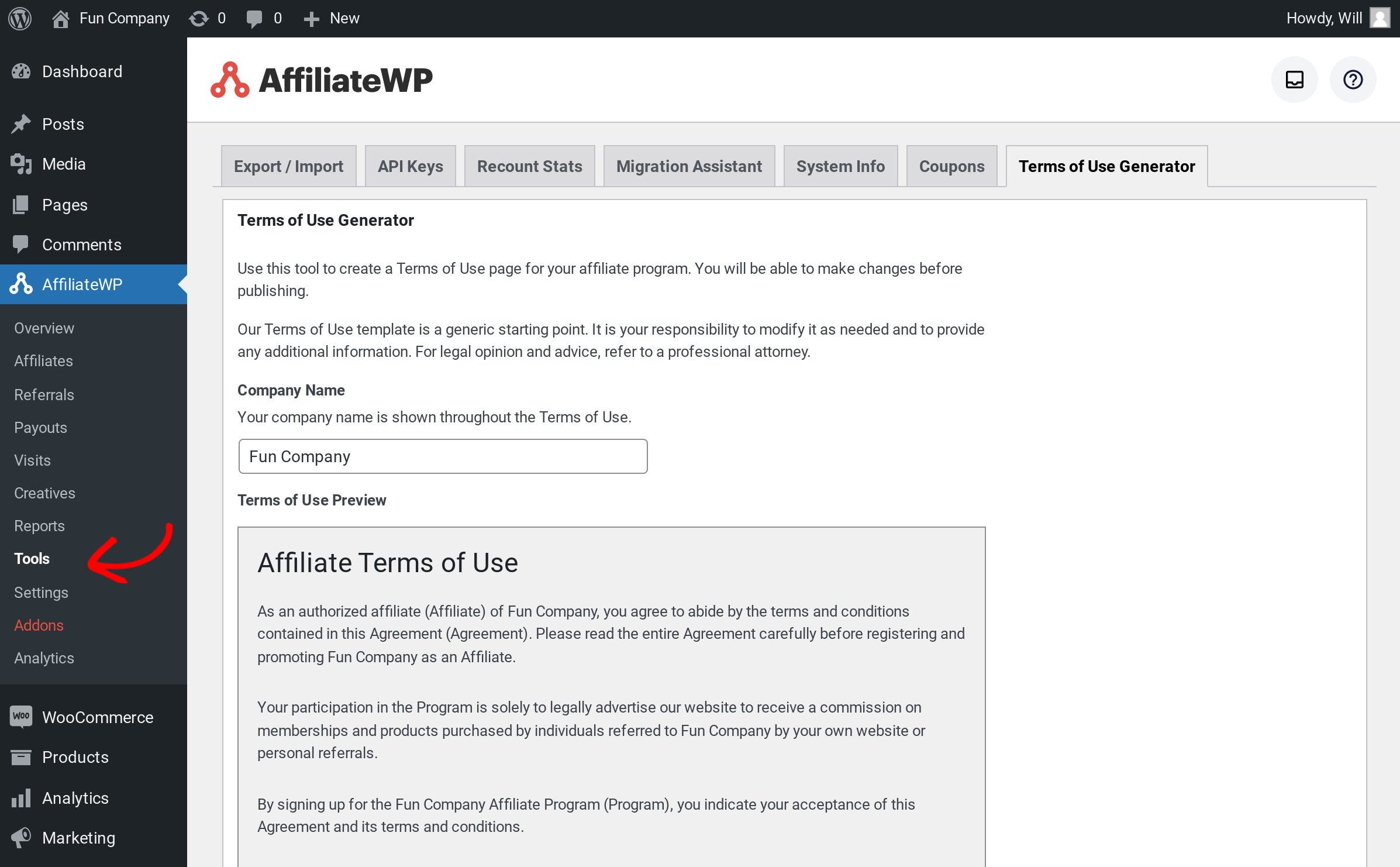
All you need to do now is enter your company name into the box, and your entire agreement will automatically be updated with the new information.
Just click Create Terms of Use Page, and you’ll be ready to publish the new page.
When you click the Create Terms of Use Page button, a new WordPress draft will open.
On this screen, you can edit your affiliate terms and conditions and add any details you want to include.
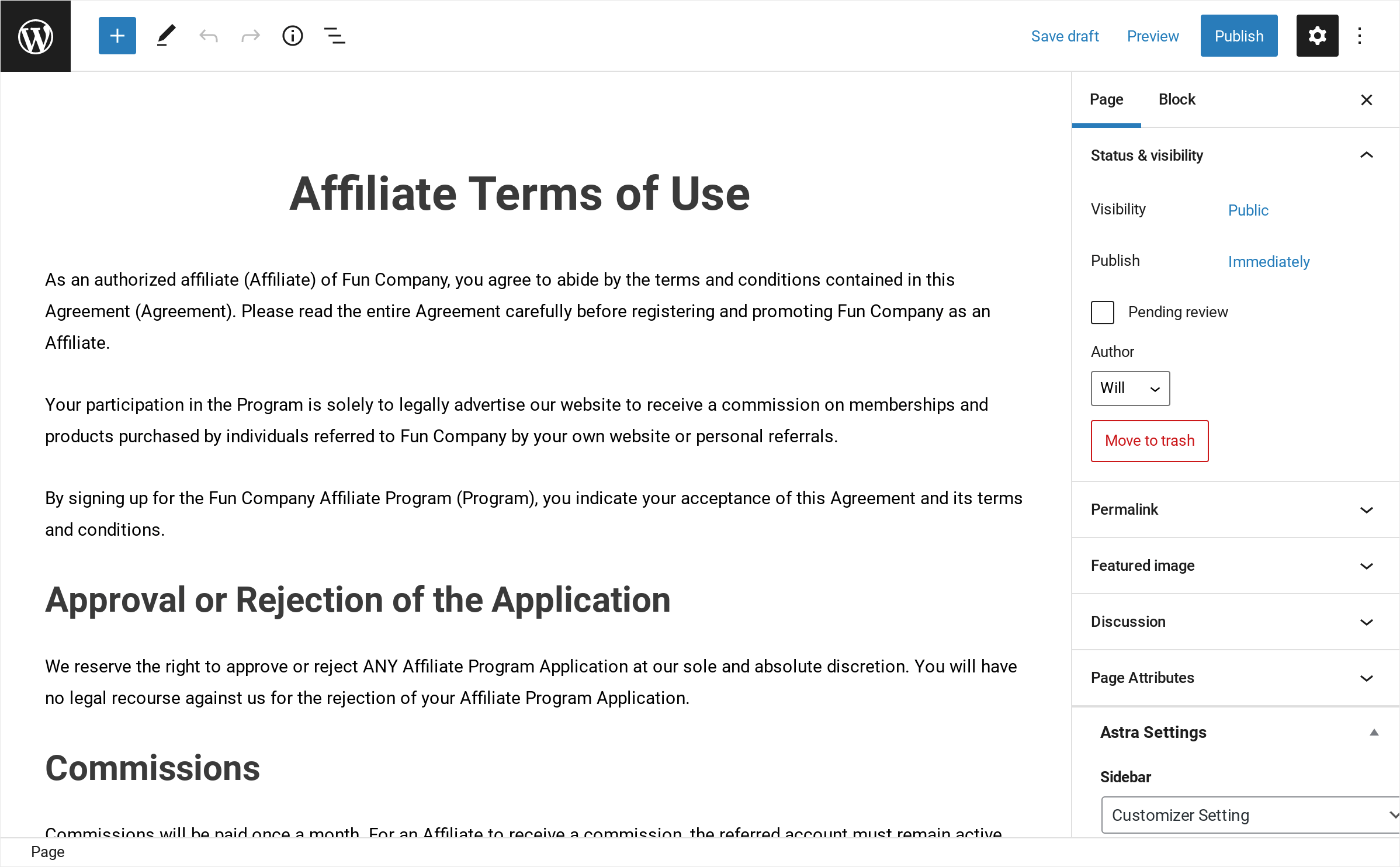
As soon as you’re happy with your work, simply hit Publish, and your affiliate partnership agreement will be live.
You can now add it to your footer, sidebar, affiliate registration forms, affiliate dashboard, social media pages, or wherever you like.
That’s it. It’s that simple with AffiliateWP’s terms and conditions generator!
One of the best places to highlight your terms and conditions is in the affiliate registration form. This is when affiliates eagerly seek information and are most likely to pay attention to the rules governing your program.
You can easily add your affiliate terms and conditions to your registration form in a neat scroll block with AffiliateWP’s blocks.
Just go to Pages and search for your Affiliate Area page. Open the page and click on the registration form, and you will see a little + button. Click the + button to bring up a list of blocks you can add to the form. Search for the Affiliate Terms of Use Block and click to add it to your form.
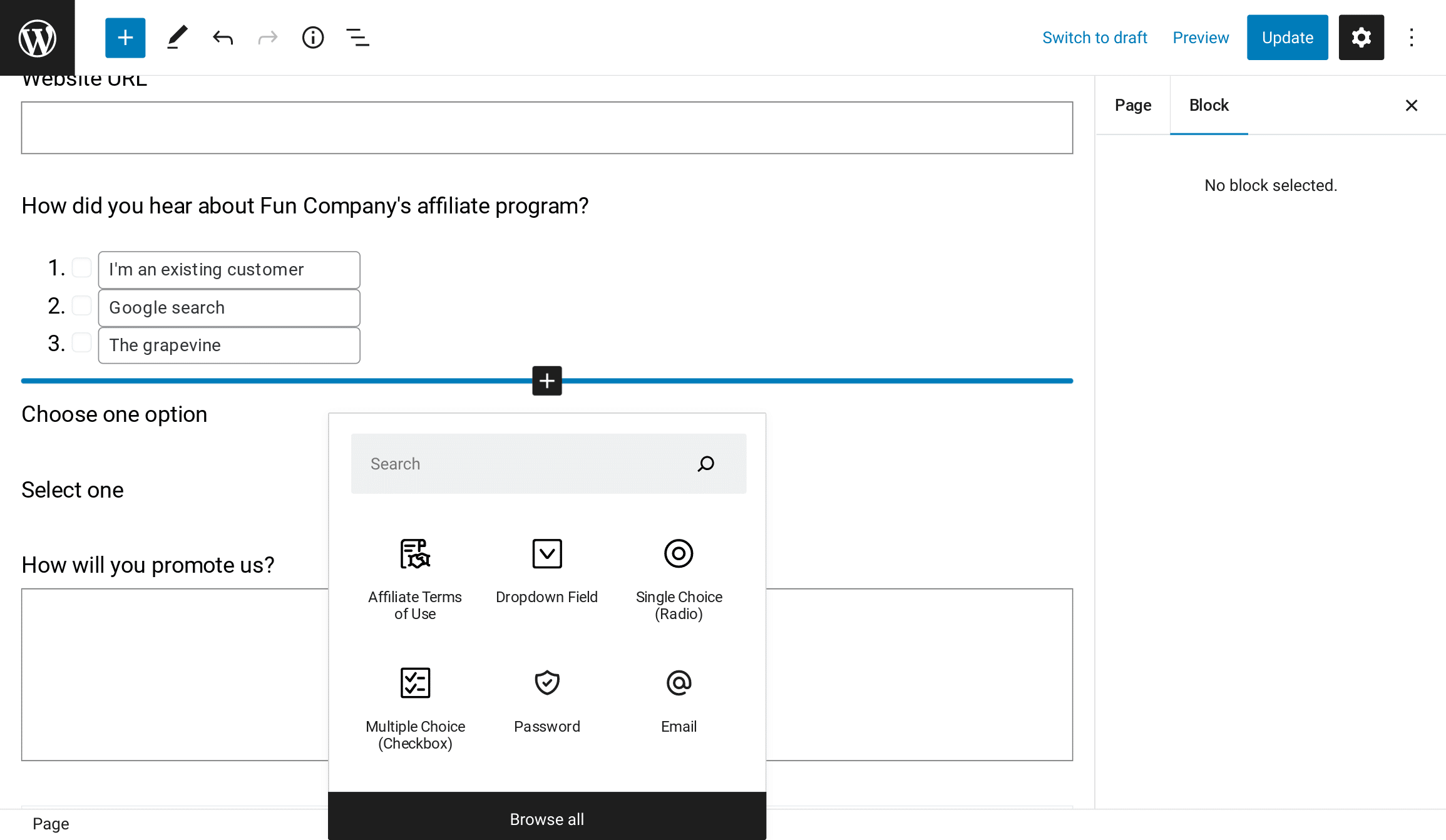
Use the search function to select your affiliate terms and conditions page, and then, in the display style options in the right-hand sidebar, check Show Above Checkbox. This will insert a box that allows your affiliates to scroll through your terms and conditions before agreeing to them.
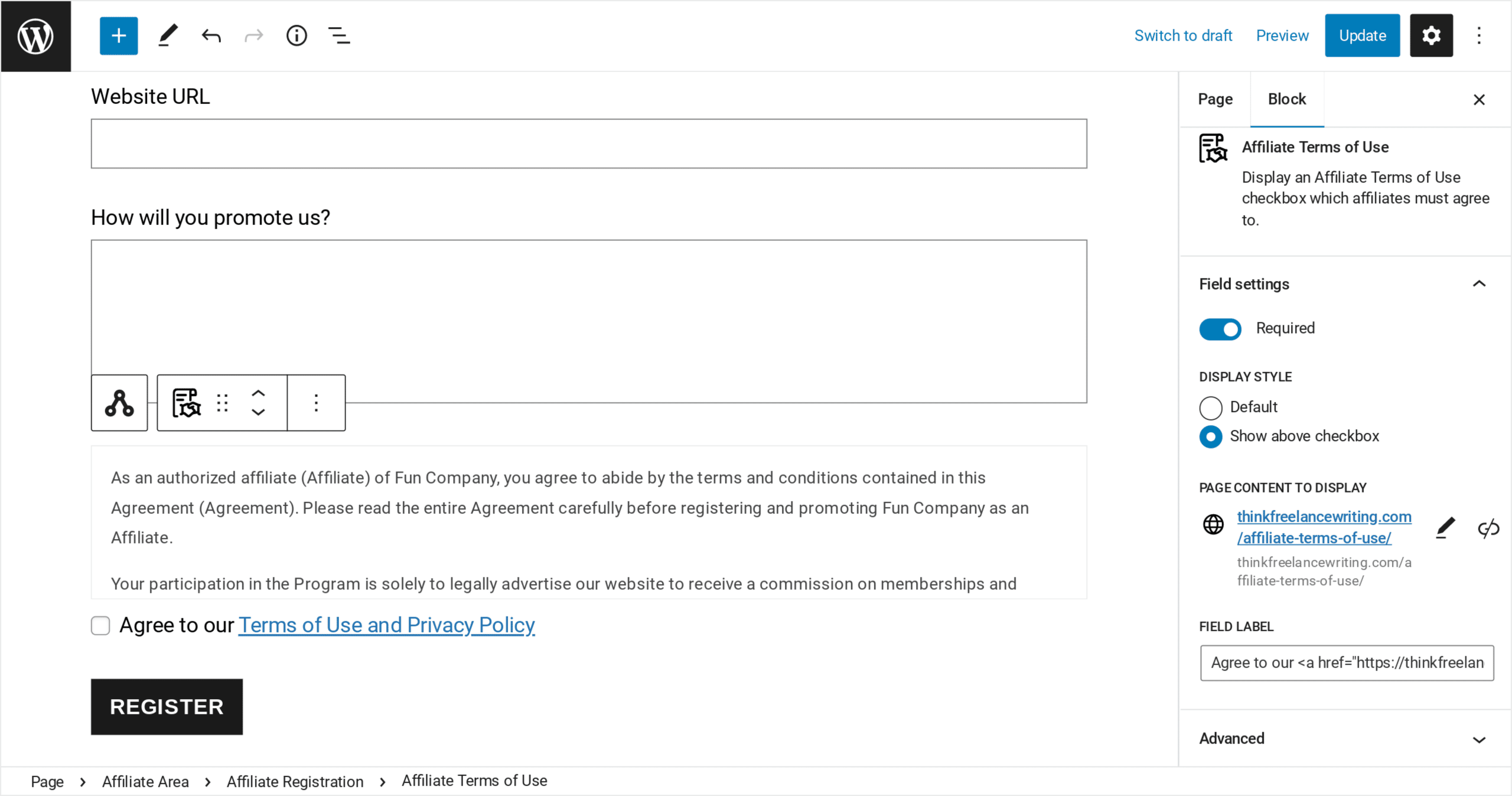
You can make this step a requirement by toggling the Required button in the block settings.
People refer to the contract you enter into with your affiliates in many ways. You’ll hear it called an affiliate agreement, affiliate terms and conditions, terms of service, operational agreement, and more.
Essentially, they’re all talking about the same thing: a contract that protects both parties.

So, how else (other than AffiliateWP’s affiliate terms and conditions generator) can you go about creating this document? There are two other options:
Nothing is stopping you from drafting your affiliate terms and conditions yourself, but when you go to a professional (although attorney’s fees can be expensive), it can give you that extra peace of mind.
Whichever route you choose, there are some basic elements your affiliate terms and conditions are likely to include.
Your affiliate terms and conditions should serve as a funnel, helping to discourage the bad affiliates and assure good affiliates of the value of your program. To do this, it’s got to be visible and easily understood.
Of course, you want to be thorough, but it’s also important to use clear language and keep it short enough that people are likely to read it.
Here are some elements your affiliate terms and conditions are likely to include.
The foreword is your introduction. Take this opportunity to welcome affiliates to the program, explain why the agreement is important, and encourage them to reach out if they have questions.

Affiliate marketing tends to use quite a bit of technical language, so a definitions section can be helpful to avoid any confusion. You don’t need to explain every word, but if you think there are some ambiguous terms used, then clarify them in this section.
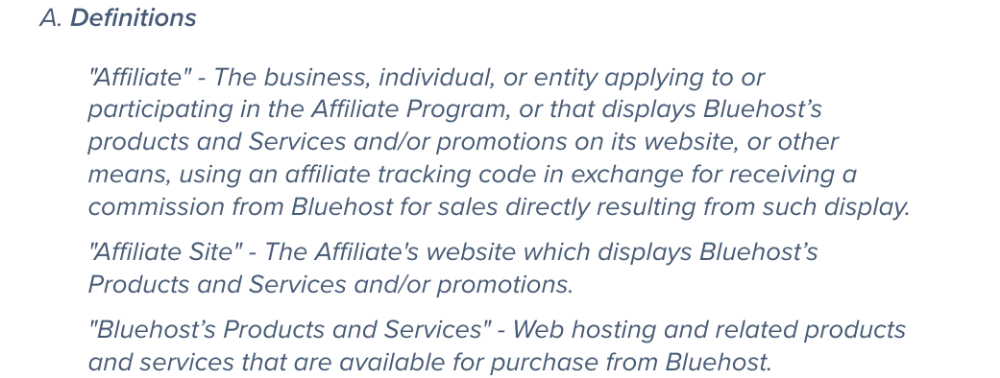
How often do you read the entirety of a legal document? If the answer is every time, then you’re probably in the minority.

Unfortunately, not everyone will read your terms and conditions, but at least if you offer a summary near the top, then people can get a good feel for what you’re looking for in an affiliate.
Whether the affiliate reads the document or not, they’ll still be bound by the rules, but you want them to understand your wants and needs as much as possible.
Focus on the most important elements of your terms and conditions like:
This will give readers a quick impression of what your affiliate program is all about.
The enrollment section should explain the enrollment process and requirements to be considered for your program.

With AffiliateWP, you can make it so affiliate signups need to be manually approved, giving you an opportunity to check the affiliate’s website, socials, and other information to make sure they comply with your requirements.
Make sure you set out these requirements and highlight all the behaviors that will exclude affiliates from registration.
Affiliate disclosures are a legal requirement. They’re there to protect consumers, but they also help protect the reputation of your brand, and your affiliates.

Your affiliate terms and conditions should state that affiliates must disclose that they receive compensation from affiliate links, which is in line with the FTC guidelines.
This is very important for the image of your program, so make sure it’s clearly stated that failure to comply will result in affiliates being removed from the program.
Part of creating a great affiliate marketing program is giving affiliates the tools they need to make sales. Generally, this will include a wide range of creatives that might use your trademark.

You must have guidelines over how affiliates use your trademarks and intellectual property rights because when used incorrectly, they can seriously harm your brand.
For instance, you wouldn’t want an affiliate replicating your website (colors, branding, navigation, everything) and then running PPC ads for your brand name to trick people into thinking they’re on your official website.
This is another extremely important section in your affiliate terms and conditions. This will govern how affiliates promote your content and the promises they make in your name.

Going back to the PPC example, if all your affiliates start bidding on your brand name, that will push your costs up. Affiliate marketing should do the opposite, so it’s important to have well-thought-out rules for your affiliates’ promotional methods.
Think about:
You might choose to ban certain (at your sole discretion) practices altogether, but it depends on the nature of your business.
A large part of any contract is defining what rights and obligations two parties have to each other. In this case, when your affiliates sign up to your program, they have certain rights, but those rights come with responsibilities.

Your affiliates’ rights and obligations might look like this:

In return, you, the merchant have your own rights and obligations:
This section dictates that upon accepting the terms of your affiliate agreement, affiliates have met certain conditions.

These will be simple things like having read and understood the agreement, being of legal age to enter the agreement, and accepting that they’re not in violation of any of the rules previously stated.
Now we get to the bit your affiliates will be frantically looking for, your payment policy!

This section should outline all details about how you track referrals, what qualifies as a referral, your affiliate commission structure, cookie policy, refund policy, and payment methods. Again, you want to keep it in simple terms, but ensure there’s no room for misinterpretation.
When your affiliates know exactly what to expect, they’re most likely to be motivated and engaged, so be open about this information.
There are some extra technical details you might want to include at the end of your affiliate terms and conditions:
If you’ve doubts, the best thing to do is look at a successful affiliate program’s terms and conditions to see what they’re doing. Consider how this matches your needs, and make changes where needed.
Now that you’ve got your affiliate program set up with comprehensive affiliate terms and conditions, it’s time to start growing your sales!
The first step in this is choosing an affiliate commission structure that promotes growth.
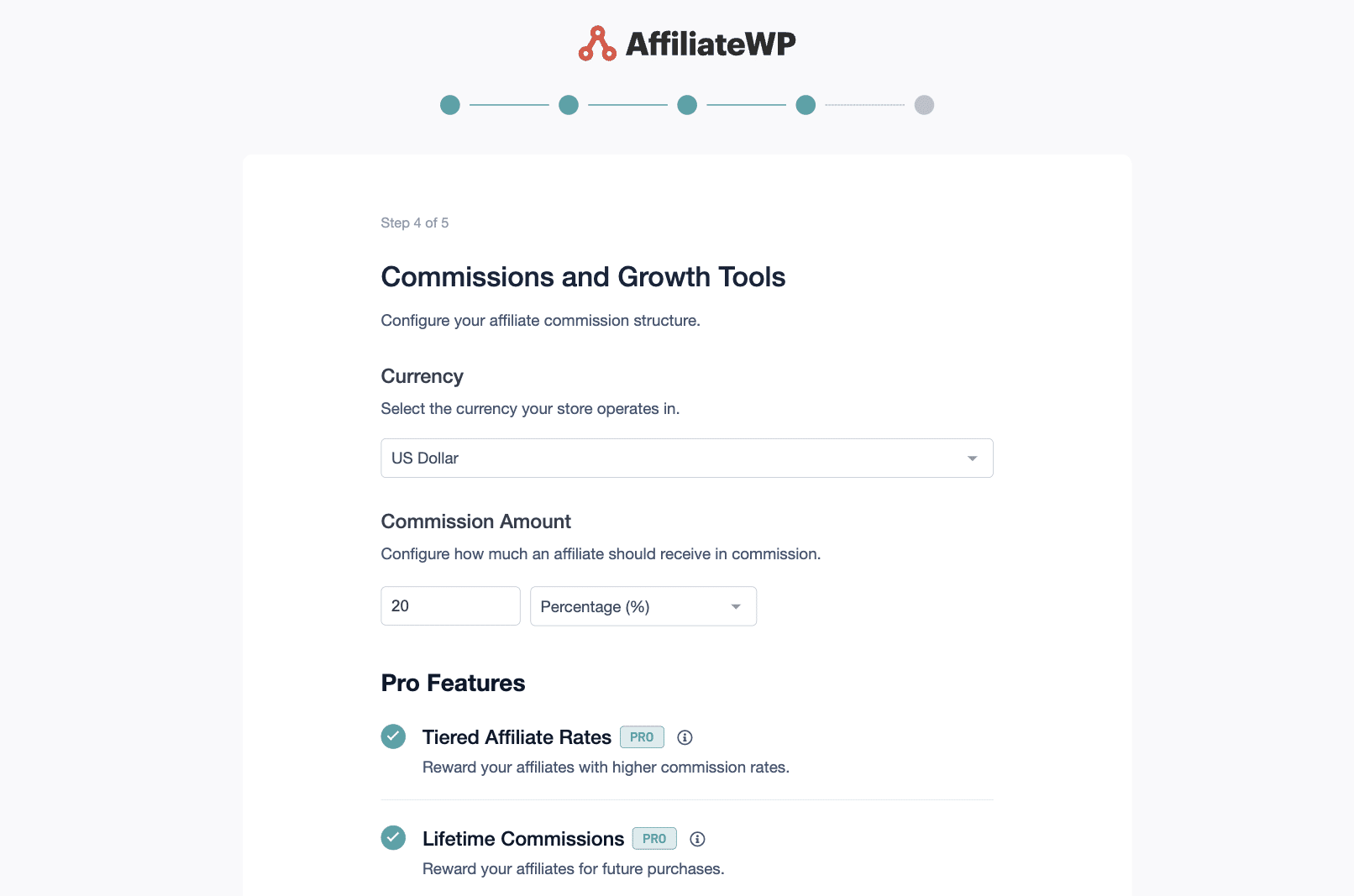
AffiliateWP offers you complete control over managing your commissions, but how should you use this flexibility?
Check out this complete guide to setting commissions to give yourself the best chance of signing top affiliates.
A good affiliate terms and conditions page provides a great base for your affiliate partnerships.
It sets expectations and governs the relationship, but what else should you be aware of as you navigate affiliate management?
Here are some great resources to help you out.
There’s only one thing left to do.
Disclosure: Our content is reader-supported. This means if you click on some of our links, then we may earn a commission. We only recommend products that we believe will add value to our readers.
Launch your affiliate program today and unlock a new revenue channel to grow your business faster.
We use cookies to improve your experience on our site. By using our site, you consent to cookies.
Manage your cookie preferences below:
Essential cookies enable basic functions and are necessary for the proper function of the website.
Statistics cookies collect information anonymously. This information helps us understand how visitors use our website.
Marketing cookies are used to follow visitors to websites. The intention is to show ads that are relevant and engaging to the individual user.